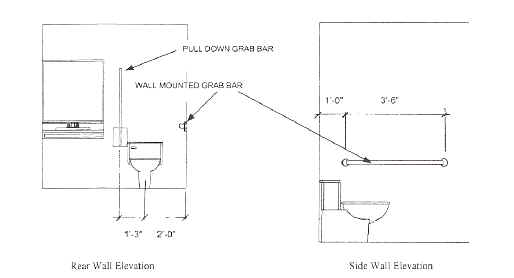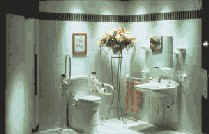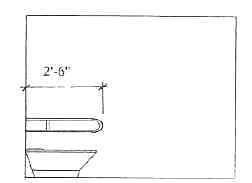Best Practices in the Design of Toileting and Bathing Facilities for Assisted Transfers
4.16.4 Grab Bars.
Among the various specifications for grab bars in general, including diameter, spacing, and structural strength (ADAAG 4.26) and for toilets in particular, including length and positioning, only the latter two were adjusted to accommodate assisted transfers.
Positioning. According to ADAAG, positioning is dependent on two factors, height and location of grab bars, both of which were altered by designers to better accommodate an older population.
Height. Only two firms, OWP&P and Nelson Tremain Partnership specifically addressed the issue of height. OWP&P used the high end of ADAAG (33") whereas Nelson Tremain used 10" above the seat height. Although OWP&P did not deviate from ADAAG, the intent was to account for the reduced stature of many older adults as well as to optimize their potential leverage. The maximum height in ADAAG was used because there was no other objective information available upon which to base a decision on effective height for assisted transfers.
In contrast, Nelson Tremain, in the absence of objective data, rationalized that height of toilet grab bars be based on the distance between the seat and arms of a chair. Thus, they decided to locate the bars 10" above the height of the toilet seat, whereas ADAAG permits grab bars 14"-19" above the seat. Although there is no evidence to support this rationale, common sense suggests that lower grab bars would enable caregivers to lean over the bars to provide assistance as well as permit individuals to be able to push up more effectively from the toilet.
Location. The ADAAG L-shaped grab bar configuration that includes a bar on the sidewall and one on the rear wall behind the toilet was consistently considered inadequate to meet the needs of people requiring assistance. As Gregory Scott, AIA, partner in RLPS, responded:
"…the major challenge with the implementation of ADAAG, is not with excessive space requirements or even required clearances; but more with achieving non-institutional appearances and being required to install assistive devices, such as wall-mounted grab bars at toilets, that serve no useful purpose for our age group [persons 78+ years of age]. We often end up installing redundant grab bars; one set to meet guidelines, the other set to meet the true needs of the resident. We are discovering that grab bars mounted at the recommended heights and distances from the toilet, both side and rear locations , are too far away to be effective for ‘self’ assistance. The seat mounted grab rail or fold-away models can place the ‘assistance’ where it is useful."
Subsequently, the rear grab bar behind the toilet was omitted in all configurations intended to accommodate assisted transfer. Similarly, the sidewall grab bar was often omitted. When this grab bar was used (e.g. Memorial Hospital of Iowa County, Dodgeville, WI, Nelson Tremain Partnership), it was intended to be used as a support for a standing individual during dressing and a swing away grab bar was provided on the opposite side of the toilet (Figure 10).

Figure 10. Grab Bar Location at Memorial Hospital of Iowa County, Dodgeville, WI (Nelson Tremain Partnership)

Figure 11. Location of Swing Away Grab Bars (Linido grab bars pictured here)
Rear-mounted (either floor or wall), swing away (or fold up) grab bars (e.g., Linido or Bobrick) on both sides of the toilet were the most popular configuration to accommodate one or two person-assisted transfers as well as independent toileting (Figure 11). Those designs that did not utilize these grab bars either used straddle bars (non-movable) that flanked both sides or simply applied ADAAG for compliance purposes and then added additional grab bars to meet the needs of the clients. Rob Pfauth, AIA, a design architect at OWP&P stated that:
"grab bars on both sides of water closets that either swing up or away obviously afford the ability for one or more caregivers to stand beside the resident and brace them while mounting or dismounting the toilet. Yet these grab bars, when in the extended position alongside the water closet provide superior leverage to the frail older adult, dependent on his or her waning upper body strength, in lowering or lifting themselves during independent toileting. Installing grab bars on both sides is important, particularly for stroke victims with hemiplegia, as a conventional sidewall grab bar on the "wrong" side is virtually useless for transferring."
Length. Whereas none of the respondents specifically addressed the issue of grab bar length, drawings submitted clearly indicate that many of the alternate swing away grab bars were considerably shorter (usually 24"-30") than the 42" minimum requirement for grab bars alongside the toilet (Figure 12). As these bars were used by individuals who often had unsteady gait and were at risk of falls, the shorter bars were likely to have been used to enable both older individuals and caregivers to get as close to the toilet as possible and thereby minimize ambulation.

Figure 12. Length of Grab Bars

User Comments/Questions
Add Comment/Question